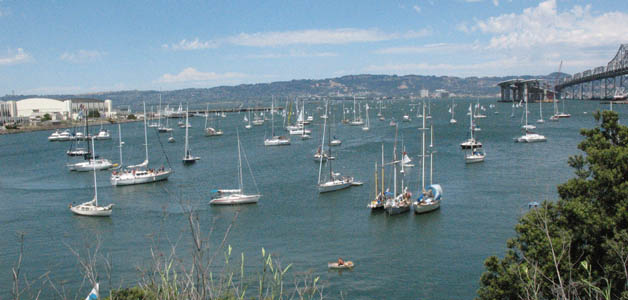In the mid-1930s, the Works Progress Administration (WPA) constructed the 403-acre Treasure Island on the shoals north of Yerba Buena Island.

Clipper Cove on Treasure Island was once used as a taxiway for PanAm’s flying boats. On June 20th it will be the site for Summer Sailstice 2009. Photo by John Arndt
By Captain Ray
Published: June, 2009
In the mid-1930s, the Works Progress Administration (WPA) constructed the 403-acre Treasure Island on the shoals north of Yerba Buena Island. The water at the site varied in depth from as deep as 26 feet to as shallow as two feet, creating a significant hazard to navigation carefully avoided by mariners for 150 years.
The island the WPA constructed measures about one mile north to south and a bit more than one half-mile from east to west. Almost 300,000 tons of rock quarried from the Bay Bridge tunnel through Yerba Buena Island was used for the construction of the stone walls that surround the island. Once these walls were completed, the interior was filled to a height of 13 feet above sea level using 20,000,000 cubic yards of mud and sand dredged from the Bay bottom.
While named as a separate island, Treasure Island is actually connected to Yerba Buena Island and the Bay Bridge by a steep causeway. One explanation for the name is the novel by Robert Louis Stevenson, who lived in San Francisco for a short time in 1879-80; another origin of the name is the gold washed down from the Sierra Nevada by hydraulic mining that is mixed in the dredged materials used to construct the island.
Treasure Island was built specifically to be the site of the Golden Gate International Exposition, which ran from February 18 through September 29, 1939 and from May 25 through September 29, 1940. The fairground was designed as a walled city (to help deflect the cool Bay breezes) filled with a maze of avenues and courts, interspersed with gardens, lagoons, and reflecting pools. Buildings with Mayan, Cambodian and Incan motifs lined the streets. All this spread out from the Central Court, where the 400-foot Tower of the Sun was erected. The entire area was landscaped with trees, shrubs and flowers from all over the world. To provide the water necessary for all these plants, lagoons and pools, a 3,000,000-gallon reservoir was quarried out of the solid rock of Yerba Buena Island and water piped across the Bay Bridge from San Francisco to keep it filled.
Only three buildings remain from this grand fair. One is the Administration Building that for many years housed a Treasure Island museum and now is the home of the Treasure Island Development Authority (TIDA). Immediately after the fair closed, though, the Administration Building served as the base of operations for Pan American Airways Trans-Pacific service from San Francisco to Manila, via Honolulu, Midway Island, Wake Island, and Guam. More recently, the building substituted for the Berlin airport in Indiana Jones and the Last Crusade.
The other two surviving buildings are the large Art Deco buildings that can still be seen on the southeast corner of the island. During the Exposition, they housed exhibits and then served as hangers for the flying boats used by PanAm. Since the 1980s, these buildings have been used as sound stages for productions as diverse as TV’s Nash Bridges and the films Flubber and The Matrix.
The small cove between Yerba Buena and Treasure Islands (often used as an anchorage by yachts) is commonly called Clipper Cove in honor of Pan Am’s flying boats, which used the cove as a taxiway. It is interesting to note that the name Clipper Cove does not appear on any official chart.
With the coming of World War II, Treasure Island became a United States Naval Base. It housed an electronics and communications training school and served as a staging area for the departure of countless ships and sailors to the war in the Pacific.
In 1996, the Navy returned control of Treasure Island to the City of San Francisco. The TIDA allows a private agency to rent out the former officers’ housing while the federal government is cleaning up other parts of the island. When this environmental clean–up is completed (approximately 2012), large scale reconstruction and development of this island is planned.
Ray Wichmann, is a US SAILING-certified Ocean Passagemaking Instructor, a US SAILING Instructor Trainer, and a member of US SAILING’s National Faculty. He holds a 100-Ton Master’s License, was a charter skipper in Hawai’i for 15 years, and has sailed on both coasts of the United States, in Mexico, the Caribbean, and Greece. He is presently employed as the Master Instructor at OCSC Sailing in the Berkeley Marina.

